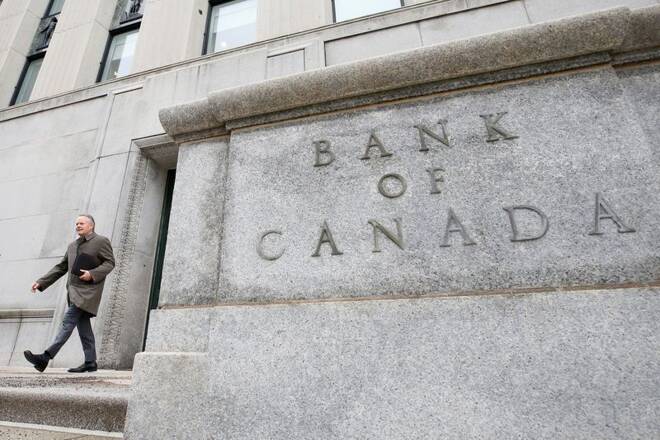Advertisement
Advertisement
A Busier Economic Calendar Puts the US Dollar and the Loonie in the Spotlight
By:
Economic data from the U.S and the BoC's monetary policy decision will draw attention today as the markets monitor the COVID-19 numbers.
Earlier in the Day:
It was a quiet start to the day on the economic calendar, with the Aussie Dollar in action once more.
Outside of the numbers, the markets also responded to the COVID-19 numbers from the early part of the week.
On Tuesday, the total number of coronavirus cases across France, Germany, Italy, and Spain rose by 15,595 to 612,061. In the U.S, the total number of cases increased by 27,509 to 613,886. That took the total number of cases globally to 1,997,666.
For the 4 most adversely affected EU member states, a run of 3 consecutive daily falls in the number of new cases came to an end. The U.S saw a run 4 consecutive daily declines come to an end. While there was a pickup in the number of new cases from the day prior, the numbers were still well below the latter part of last week.
While the coronavirus numbers were still market positive, the IMF weighed on risk appetite. Overnight, the IMF warned that the global economy would see its worst slowdown since the Great Depression. It revised its growth forecast for 2020 from 3.3% growth to a 3% contraction. For the U.S, the IMF forecasted a contraction of 6% and raised doubts of a V-shaped rebound.
For the Aussie Dollar
Consumer confidence took a hit in April, with the Westpac Consumer Confidence Index sliding by 17.7% to 75.6. Economists had forecast a 15% fall to 78 following a 3.8% decline to 91.9 in March.
According to the latest Westpac Report,
- The monthly decline was the largest in the 47-year history of the survey, with all 5 component sub-indexes on the slide.
- Looking at the sub-components:
- The economy, next 12-months sub-index slid by 31% to 53.7, with the time to buy a major household item falling by 31.6%.
- Time to buy a dwelling slid by 26.6%, with the House Price Expectations Index tumbling by 50.8%.
- Family finances vs a year ago fell by 14.8% to 70.4, with family finances next 12 months falling by 6.6% to 90.9.
- The economy next 5-years saw a modest 3.8% decline, while the Unemployment Expectations Index rose by 8.2% to 158.1.
The Aussie Dollar moved from $0.64255 to $0.64286 upon release of the figures. At the time of writing, the Aussie Dollar was down by 0.29% to $0.6423.
Elsewhere
The Japanese Yen was up by 0.18% to ¥107.03 against the U.S Dollar, while the Kiwi Dollar was down by 0.44% to $0.6079.
The Day Ahead:
For the EUR
Its relatively busy day ahead on the economic calendar, with finalized inflation figures for France, Italy and Spain due out.
Barring a deviation from prelim figures, however, the March figures are unlikely to have an impact on the EUR.
The markets are expecting deflationary pressures to build as a result of the lockdown…
At the time of writing, the EUR was up by 0.05% at $1.0985.
For the Pound
It’s yet another quiet day ahead on the economic calendar, with no material stats due out of the UK later today.
A lack of stats will leave the Pound in the hands of market risk sentiment and the latest COVID-19 numbers.
Medical experts have predicted that the virus will peak late this week. This continues to support an easing in containment measures at the end of the month, assuming that there is no sudden uptrend in new cases.
While the UK is expected to fall into a recession, a 1-month shut down would support a speedier economic recovery.
At the time of writing, the Pound was down by 0.02% to $1.2620.
Across the Pond
It’s a busy day ahead on the U.S economic calendar. Key stats due out this afternoon include March retail sales and industrial production figures and April’s NY Empire State Manufacturing Index.
While March retail sales figures could be skewed as a result of hoarding, industrial production and manufacturing numbers will garner plenty of interest.
Outside of the numbers, the markets will also be looking for further updates on which states are likely to ease lockdown measures.
The Dollar Spot Index was down by 0.03% to 98.861 at the time of writing.
For the Loonie
It’s another quiet day on the economic calendar, with no material stats due out of Canada to provide the Loonie with direction.
A lack of stats will leave the Loonie in the hands of crude oil prices and the Bank of Canada. The weekly API and EIA inventory numbers will be in focus along with the IEA’s monthly report.
Further talk of oil producers cutting production by a further 10m bpd would be Loonie positive, as would a continued fall in the number of new coronavirus cases.
On the monetary policy front, no further rate cuts are expected, leaving forward guidance to set the tone.
The Loonie was down by 0.17% at C$1.3906 against the U.S Dollar, at the time of writing.
About the Author
Bob Masonauthor
With over 28 years of experience in the financial industry, Bob has worked with various global rating agencies and multinational banks. Currently he is covering currencies, commodities, alternative asset classes and global equities, focusing mostly on European and Asian markets.
Advertisement
